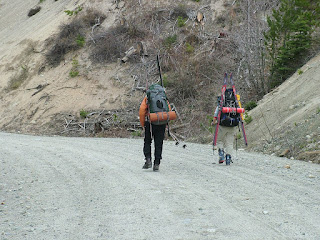This essay is a satirical look at
bulletin boards, forums and the people who populate them. It is a
work of fiction and is intended to be humorous. All characters
appearing in this essay are fictitious and any resemblance to real
persons, living or dead, is purely coincidental.
So, you're fat, bald and outta shape,
and the hardest thing you've ever climbed is a one pitch sport route
or grade III ice climb (which you didn't lead). Your skiing career
is similarly lackluster - lots of resort skiing, and even some slack
country, but you've never done a traverse, and the highlight of your
ski career is bumbling your way up some easy ski peak. You've got
few friends, fewer climbing and skiing partners, you've squandered
any minor talent you did have, and you're stuck in a dead end job
with a bunch of other losers. In short, your life is a long list of
shoulda, coulda, woulda. And yet, you want to be a bigshot.
Or, maybe you're tall, skinny, have
plenty of hair, you train a little bit, and you think you're training
hard, but, really you're as weak as tepid bathwater, and an 86 year
old Crossfitter would kick your butt. You are proud of being the
strongest person in your group, but my grandmother, who never climbed
or skied, and has been dead these past 30 years is stronger than the
strongest person in your group (and it ain't you, dude). You suffer
from such terminal nervousness that the hardest thing you've ever led
is 5.6 on bolts, every two metres, and even then you were scared
shitless. But you too want to be a bigshot.
The easiest place to be a bigshot is on
an Internet bulletin board, preferably one that is designed, run and
populated by people in a place distant to your own area. If you live
in the east, join one in the west, or, if you live in the
Intermountain ranges, join one from the Coast Ranges. What you don't
want to do is join a local bulletin board where people will actually
try to hook up with you and go out climbing and skiing. This must be
avoided at all costs, as, these good folk will find out exactly what
a loser you are.
The first thing you need to do on your
chosen bulletin board is work out the hierarchy. You are looking for
people who are as useless as you and, who are also (like you),
pretending to be something they are not. Befriend these people. A
judicious mix of bullying and sycophancy will win them over to your
side. Don't worry, it won't be too hard. These people are just like
you - weak, frustrated, angry, short on brains, but long on invective
- they will recognize you for what you are and be only to happy to
hitch their ego to yours.
You also need to work out who is really
out there doing stuff - you know, the climbing and skiing that you
pretend you do, but don't. As sure as Alberta votes Conservative,
these people will be able to see through all your bullshit and will
recognize you for what you are - an odious little pissant. Attack
these people ruthlessly. Ageism, sexism, racism, any other ism you
can think of is your friend here. The people who are really out
doing stuff, especially if they are older than you or of a different
gender, present twice the threat to your ego as someone who is your
own age or gender. Hold nothing back. Again, don't be afraid, this
is not nearly as threatening as giving it all you've got when you're
out skiing or climbing. On a bulletin board, you can give it all
you've got without facing any real fear of failure, and, all from the
comfort of your parent's basement. You need never break a sweat, take
a fall, or break a trail, you can concentrate on the real work of
breaking people.
Have no morals. Don't worry about
exaggerating or even out right lying about what you've done. So,
you've never climbed a multi-pitch alpine route or built a
multi-directional gear anchor, fake it. Ski 50 days a year, all of
them at a resort, make it a 100, or better yet, 130, and all in the
backcountry. These people are all so far away they'll never ski with
you and realize that, far from being the next Greg Hill, you can
barely drag your sorry arse up a short hill without getting winded.
Lack of any kind of experience, such as mountaineering (real
mountaineering not snow slogs or scrambles), multi-pitch climbing,
multi-day ski traverses, climbing or skiing new routes, is not a
reason to refrain from talking big. In fact, it's a reason to talk
even bigger. Never climbed in the US, Mexico, Europe, in fact, never
been out of your own backyard, again, no need to admit this
shortcoming. A Google search will tell you all you need to know.
Think big, talk big, just don't go big.
If, after all the bullshit, insults,
lies, invective, and vituperative drivel you've spewed forth, the
unthinkable happens and you get banned, don't stay away. Come back.
The fact that these people don't like you and don't want you around
is irrelevant. You have work to do here. You're a big shot. Create
one, two, even three sock-puppets and keep that bullshit going.
Don't waste any of your precious mental acuity (had to look that one
up didn't ya?) on creating an alter-ego that is hard to recognize.
After all, you're smarter than all the other people on the bulletin
board aren't you - or are you?
Always have the last word. Even
better, make the last word another insult. Preferably, use insults
that actually reflect truthfully on your own character. Are you a
liar, a cheat, a hypocrite, if so, these should be your insults of
choice. Projecting your own insecurities on other people is a sure
way to deflect any need for critical appraisal of your own character.
And finally, never underestimate the
staying power of continuing to argue long after everyone else has
left the discussion. So what if the last ten replies in the thread
are all yours. After all, the great mountains of the world were
eroded down to minor sand dunes by a steady drip, drip, drip, just
like your personality.















